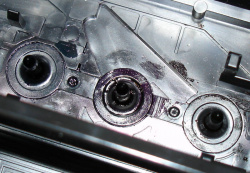Printer cleaning How to clean Epson print heads: White pages or bands - immediate cleaning is essential
What shall I do...?
First check the cartridges: Are they correctly attached to the print head?
If you use low price or quality ink (especially the one sold by Pelikan), the reason for empty pages or bands might be just that.
Newer Epsons using Durabrite ink are very sensitive when low quality ink is used.
Printers with original inks do not tend to clogging too soon (my R300 printed faultless and without cleaning after an idle period of several months).
As a first try you should use original ink. To continue printing or cleaning with a cheap ink will aggravate the situation.
What colors are involved?
If you have a print with stripes and smudges it´s hard to detect, which colors are missing or which nozzles are clogged.
You can find that out by printing the nozzle check pattern: Use "Utility" in the printer driver.
Cleaning...
At first I would try a normal cleaning (Printer driver, "Utility"). If this method shows no result after three or four tries, stop that: It consumes a lot of expensive ink. Try something else.
Power cleaning
If normal cleaning show no results, Epson´s hotline suggests a power cleaning.
That´s the way it works::
- Use a word processing program and fill about one quarter of a page with characters (no graphics, no blanks)
- Colorate the text with the colors you think that are (partially) missing
- Print the text
- Within five seconds after the printout press the cleaning button for several seconds.
- Start a second hardcopy of your text document while the cleaning process is in progress
Repeat this process several times. The cleaning intensity will increase by every additional procedure.
If nothing is changing to the better after five or six cleaning cycles, do something else, since power cleaning uses up a lot of ink.
If warranty hasn´t expired yet, send your printer to an Epson Service Center![]() . We heard the service there is pretty fast.
. We heard the service there is pretty fast.
If power cleaning doesn´t work...
...your skills are now being called upon.
CAUTION! Avoid spilling ink on your clothes, carpets, furniture. Ink spots are hard to remove.
Dismounting an Epson print head is bloody complex. You have to disassemble half the printer. After finishing your work you may use the same procedure as with Canon´s print head, using distilled water or alcohol.
For a "manual" cleaning you have to get the print head out of its parking position. To do that either press the paper transport button for three seconds or start a cleaning job and pull the power cord, when the print head is out of the parking position.
First method…
Take a paper towel or a tissue handkerchief and saturate it with alcohol. I use isopropyl alcohol. Put it into the printer in a position the print head can move over. Carefully position the print head on the tissue. Leave it there for a couple of hours.
After that remove the tissue, switch on the printer, and perform one or two cleaning cycles.
If this road leads to no success, brute force is required (since you have nothing to lose...).
Second method ...
Remove the ink tanks from the print head. Take a piece of paper, prepare it like in method one, and place it below the print head.
Fill a syringe with alcohol or warm distilled water and attach one end of a plastic hose (a few millimeters wide) to it. Mount the other end of the hose to the opening where ink enters the print head. Carefully inject the fluid and press it through the print head.
Remove syringe and tissue, perform a couple of cleaning cycles (ink has to refill the print head), and hope ;)...
If that has proved useless...
...forget about your print head, if your warranty has expired. A repair may cost you as much as 100 Euros. An exception could be more expensive printers (A3).
If your print heads dries up frequently…
...this could be caused by unsuitable ink or an inappropriate location of the printer. Heat (hot radiator too close? attic room? window? sun?) can considerably expedite the drying process.

 Opening in the print head: Attach the syringe`s hose to it.
Opening in the print head: Attach the syringe`s hose to it.